Beware the Buttercups
"A blend of innocence and malintent...poisonous within..."
"Each premature death attributed to Long COVID carries substantial societal financial repercussions, prompting attention to various economic concepts during the pandemic to unravel the complexities of these billion-dollar questions."
(J. Formos Med. Assn.)
The highlights:
The H.E.L.P. Committee draft proposal makes no mention of funding for distribution of treatment, viral load tests (detection), clean air, respirator mandates, or other meaningful measures to prevent Long COVID by preventing COVID.
NIH already hosts LitCovid, an ever-growing online research library of more than 400,000 studies relating to SARS-CoV-2.
The federal government has already created an HHS office and an NIH research branch for Long COVID.
We KNOW how to do many of the things outlined in this proposal, but are still unwilling to implement the steps necessary to accomplish them. That continues to be evidenced in this proposal by a lack of clean air measures, failure to instate high-quality respirator measures in healthcare settings to protect patients (this is the bare minimum), discontinuance of Test2Treat, removal of COVID treatment guidelines from the CDC website, defunding of telehealth, etc.
You also should know that critics of NIH budgets and funding proposals have been concerned for years that private institutions are going to have better opportunities at advancing research due to constraints and political motives within NIH. The FY2024 NIH budget confirms that Long COVID is not only not a priority, it is hardly mentioned at all. The topic is briefly mentioned on 3 separate pages, and once is simply to pat the agency on the back for their work in monitoring the situation. (Yes, I read the budget - pages 4, 60, 62.) The FY2025 NIH budget request was submitted a month ago. More info here.
So…what have we done?
RECOVER was given an initial $1.15B in 2020. After 2 years, the NIH’s Long COVID research initiative had yet to begin any clinical trials and it was running out of funds. In April 2023, RECOVER announced it might begin trials later in the year. Now, in April 2024, RECOVER has been given BILLIONS in funding, and we have seen no results warranting another NIH-based research initiative.
Here is a comprehensive timeline of federal Long COVID funding and actions to date:
12/20 - Congress allocates $1.15B to NIH
02/21 - NIH announces RECOVER initiative
06/21 - First round of grant funding dispersed
09/21 - NYU begins recruiting for observational study
04/22 - Biden makes unkept promises to the Long COVID community in a memo
06/22 - NIH tells Congress trials will begin fall ‘22
08/22 - HHS releases a detailed National Research Action Plan on Long COVID. No action has been taken on the plan.
08/22 - HHS releases Services and Supports for Longer-Term Impacts of COVID-19
08/22 - Duke announces clinical trials effort
08/22 - Observational study fills all slots
10/22 - Duke announces Paxlovid trials, est. start early ‘23
12/22 - Patients begin to push back on proposed exercise study
02/23 - NIH tells advocates it doesn’t plan to ask for more $$
03/23 - Biden budget doesn’t include RECOVER funding
04/23 - Duke gives est. summer ‘23 trial start date
07/23 - HHS announces the formation of the Office of Long COVID Research and Practice
09/23 - HHS awards $45M in grants to existing Long COVID clinics
01/24 - Senate HELP Committee holds hearing: Addressing Long COVID
02/24 - Congress allocates additional $515M to NIH for research
So why should we trust that another federally-funded, NIH-controlled research initiative will finally be the answer to years of advocacy efforts?
Will a $1B/year for 10 years Long COVID Moonshot save our lives?
…
Maybe not.
Let’s get into it.
PART I - AUTHORIZATION OF APPROPRIATIONS, REPORT
We know 1 in 5 will report Long COVID. In America, that could be more than 66.6M people with symptoms of Long COVID, with more COVID infections occurring daily. Does that mean all 66.6M of those Americans will need antivirals, intensive care from specialists, and care from Long COVID clinics? We don’t really know. It’s only been four years. However, based on the “official” government count used for this proposal, only 28M people are considered to be dealing with Long COVID. Given the number of COVID cases we’ve seen in the United States (or the COVID cases that have gone dismissed as “just a cold,” “allergies,” or “no big deal” because the CDC said it was fine to go to work while ill), we may be looking a criminally low undercount. Many of these cases will forever go unrecognized and unreported, resulting in seemingly “mild” changes to health that lead to long-term disability or sudden death. Any way you look at it, the math doesn’t add up.
1 in 5: $1B per yr / 66.6M = ~$15/yr per pwLC
1B for 28M: $1B per yr / 28M = ~$33/yr per pwLC
According to a report on the worldwide economic implications of Long COVID published in Jan. 2024, the current average Value of Statistical Life (VSL) stands at approx. $7.2M. The VSL is also referred to as the “value of a prevented fatality." The VSL does not directly place a value on the worth on an individual human life, but aims instead to calculate the monetary value an individual is prepared to spend to slightly decrease their likelihood of death. By chronically underfunding these programs, the federal government shows that they place little-to-no value on patient lives. The average American may be willing to pay $7.2M to save their own life, but our federal government will only allot $15-33.
Economist Mark Cutler estimated the cost of Long COVID to the economy to be $3.7 trillion over 5 years. According to Cutler, we would need at least $28B/yr for Long COVID research. This doesn’t feel like a huge number, considering the way other diseases are funded.
Cancer: $1.8B in additional funding for “acceleration in progress for cancer” - on top of annual research budget of $7.22B. The last of these 7 Moonshot disbursements was given in 2023 at $216M. There are currently 123 sites funded by the National Cancer Institute. There were 2M cancer diagnoses in 2023.
Cancer research funding per person: $3,611.08/yr and 123 National Cancer Institute designated-sites, a group of research institutions supported by NIH
Equivalent research funding for 28M pwLC Long COVID: $101.1B/yr
HIV: $3.294B funded for research in 2023. This budget covers 1.2M people and does not include social services, treatment, education, or other funded areas of the HIV budget. The Office of AIDS Research has requested a 20% budget increase for FY 2025 NIH HIV research, or $659M, which would bring the total NIH HIV research budget to $3.953B.
HIV research funding per person: $2,745/yr and there are already 26 approved treatments on the market
Equivalent research funding for 28M pwLC Long COVID: $80B/yr
A single Hepatitis C drug costs approximately $900M to develop, trial, and market to pharmaceutical companies. Patients will pay ~$1,000/pill for drugs like Sofosbuvir. (These are antivirals, and we’re talking repurposing antivirals here, so let’s be realistic about costs). It is a joke to offer $1B/yr to Long COVID and “other conditions.”
Are you starting to get the idea? Just to refresh your memory here, the Long COVID Moonshot proposal doesn’t even allocate enough funding to cover the cost of having Quest come to the homes of all 28M+ pwLC to draw a single set of labs ($55.00), but expects that these same Long COVID patients will be okay with the proposal co-opting ME/CFS, POTS, MCAS, EDS, Lyme, etc. - and underfunding all of them at once.
Is this what solidarity looks like?
Given that many people with Long COVID are losing their homes, defaulting on medical and other debt, having cars repossessed, being forced to utilize legal aid services, and turning to state or federal benefits to survive. If we only fund this proposal at $1B/yr and slow-roll the advancements toward effective treatment, social supports, and real prevention, Long COVID is going to cost the economy a hell of a lot more than $3.7T.
PART II - ESTABLISH A LONG COVID RESEARCH PROGRAM AT THE NATIONAL INSTITUTES OF HEALTH (NIH)
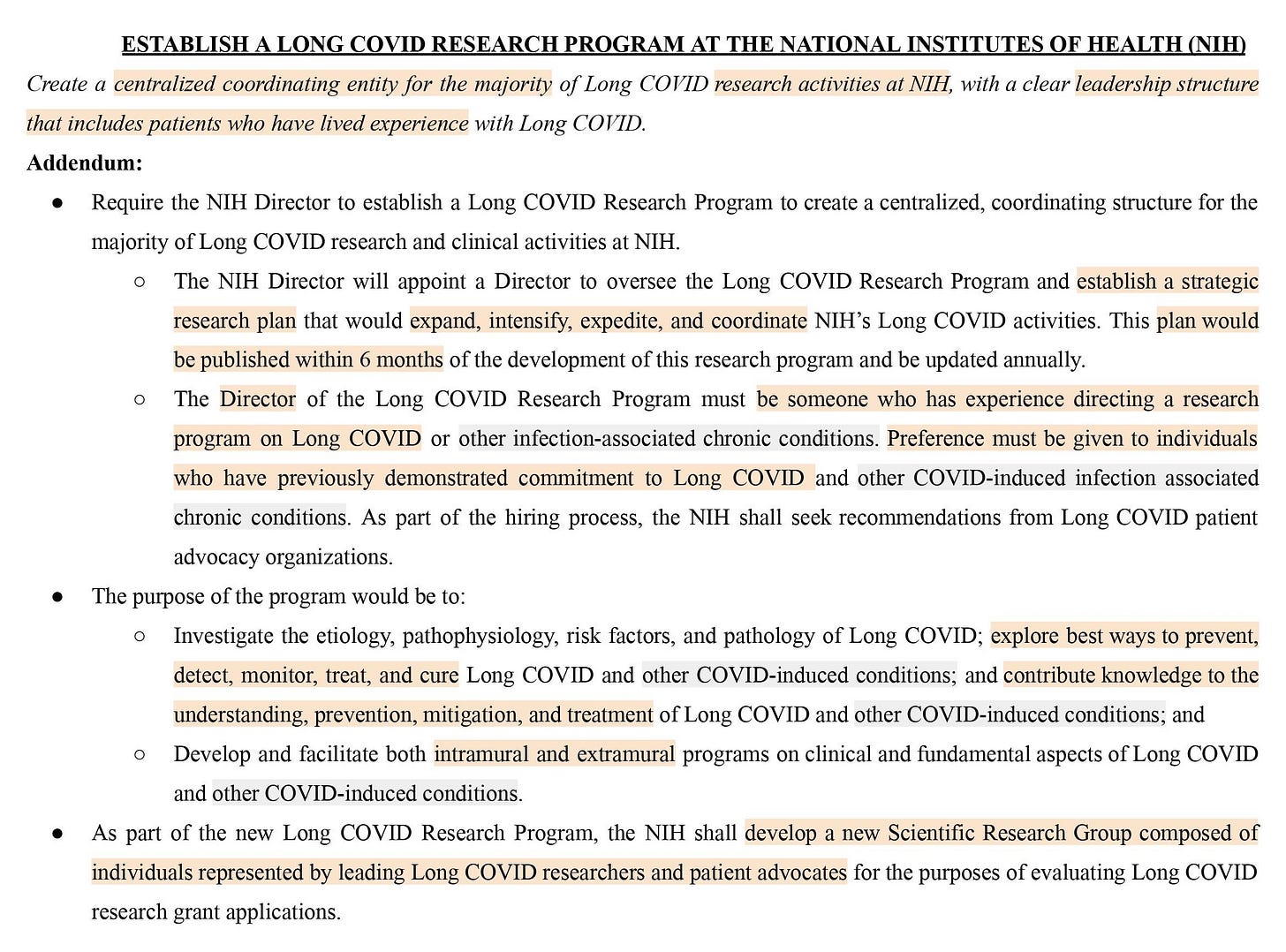
Next: The Long COVID community, scientists, researchers, and other stakeholders have raised serious concerns over an NIH-centric Long COVID research body and ways in which it will further restrict funding to government-controlled areas of study.
The federal government also has already established an office of Long COVID under the HHS, and a branch for Long COVID research at the NIH (RECOVER). HHS has operated largely under the radar, as they do, publishing lengthy documents with links to existing government resources and selectively funding the same Long COVID sites repeatedly. They specify that their grants will go to:
“…support existing multidisciplinary Long COVID clinics across the country to expand access to comprehensive, coordinated, and person-centered care for people with Long COVID, particularly underserved, rural, vulnerable, and minority populations that are disproportionately impacted by the effects of Long COVID.”
These nine grants will be given at $1M/yr each for up to 5 years, totaling $45M. In their first year, they should have dispersed $9M in grants, but there is currently $119,497 unaccounted for. It isn’t uncommon for agencies to not disperse funds if organizations don’t ask for it, but HHS has a history of misappropriating research funds. Between 2010 and 2020, the Office of Assistant Secretary for Preparedness and Response (ASPR) failed to report to Congress nearly $543M appropriated to the Biomedical Advanced Research and Development Authority (BARDA) to fund vaccine research and emergency preparedness for public health threats like COVID-19, Ebola, and Zika. In a Disclosure of Wrongdoing, the U.S. Office of Special Counsel informed the President and Congress that ASPR used research funds to pay for furniture removal, news subscriptions, non-BARDA personnel salaries, legal services, and other unrelated expenses. The misuse of funds was a common enough practice that it had been given the nickname “Bank of BARDA.”
The misuse of funds was a common enough practice that it had been given the nickname “Bank of BARDA.”
I have no issue with funding clinics. I do think that all Long COVID clinics should be funded, and funded well. I also think we need better support, respirator mandates in healthcare facilities, telehealth, viral load tests, and viable antivirals for the Long COVID community to show for it. I also think NIH and HHS have transparency issues, and I don’t trust that saying “Long COVID” and standing up too fast is going to change anything.
We need more clarity: Does “lived experience” mean people with Long COVID or patients/orgs who have "recovered from Long COVID" and "advocated" for Long COVID patients? We saw at the H.E.L.P. hearing that the most severe Long COVID patients were left out of the conversation and their voices were replaced with Infection-Associated Chronic Condition and ME/CFS orgs. In the same way that pwME do not want to be spoken for and misrepresented, pwLC want the same respect.
Publishing a strategic research plan 6 months from the date of the development of this program does not convey "intense" and "expeditious" in the manner that a "public health emergency" or "crisis we cannot ignore" demands. It is important to recognize that on this timeline, some pwLC currently fighting for this funding may no longer be alive.
Now, there has been a lot of back-and-forth around the use of the language like "Long COVID or other infection-associated chronic conditions." This phrasing is used repeatedly throughout the draft proposal, but we’re going to table it for the moment. We’ll get there. It’s problematic for a number of reasons, and I’m going to ask you to bear with me. It’ll be worth it.
The door has been opened for a Director to be appointed that has
no real knowledge of Long COVID,
a minimizer,
a politician,
All of the above
The NIH has done it before, they're doing it now, and they'll do it again. The same person the NIH hired to bury ME/CFS and MS is well on his way to burying Long COVID for the NIH as we speak. If you remember, researchers like Brian Walitt have been working for NIH for ages, and have been paid to conclude that ME/CFS is a somatoform disorder with "often a degree of attention-seeking." He’s been hired in the past to conduct intramural studies for ME/CFS, Gulf War Illness, and now, SARS-CoV-2. It’s only a matter of time before he concludes that Long COVID is an “effort-preference” disease - meaning it is something patients “do” rather than something patients “have/happens to them.” Patient and advocate Colleen Steckel wrote a must-read breakdown of the study that raises further questions regarding NIH’s ability to conduct unbiased research with results applicable to their target populations.
“Effort preference”—what the fuck? If you focus-grouped it, you couldn’t come up with a more demeaning and ridiculous name for the construct presumed to be driving the disabling symptoms that plague this particular group of patients.
I “can” go for a walk around the block. The enjoyment reward would be significant. But the knowledge that the aftermath of that walk would be symptoms that could land me in an emergency room is always part of my decision about doing a task.
It’s also possible that a Director may be appointed who has experience with a different chronic illness (think SolveME).
As far as investigating the etiology, pathophysiology, risk factors, and pathology of Long COVID, well, let’s clear that up.
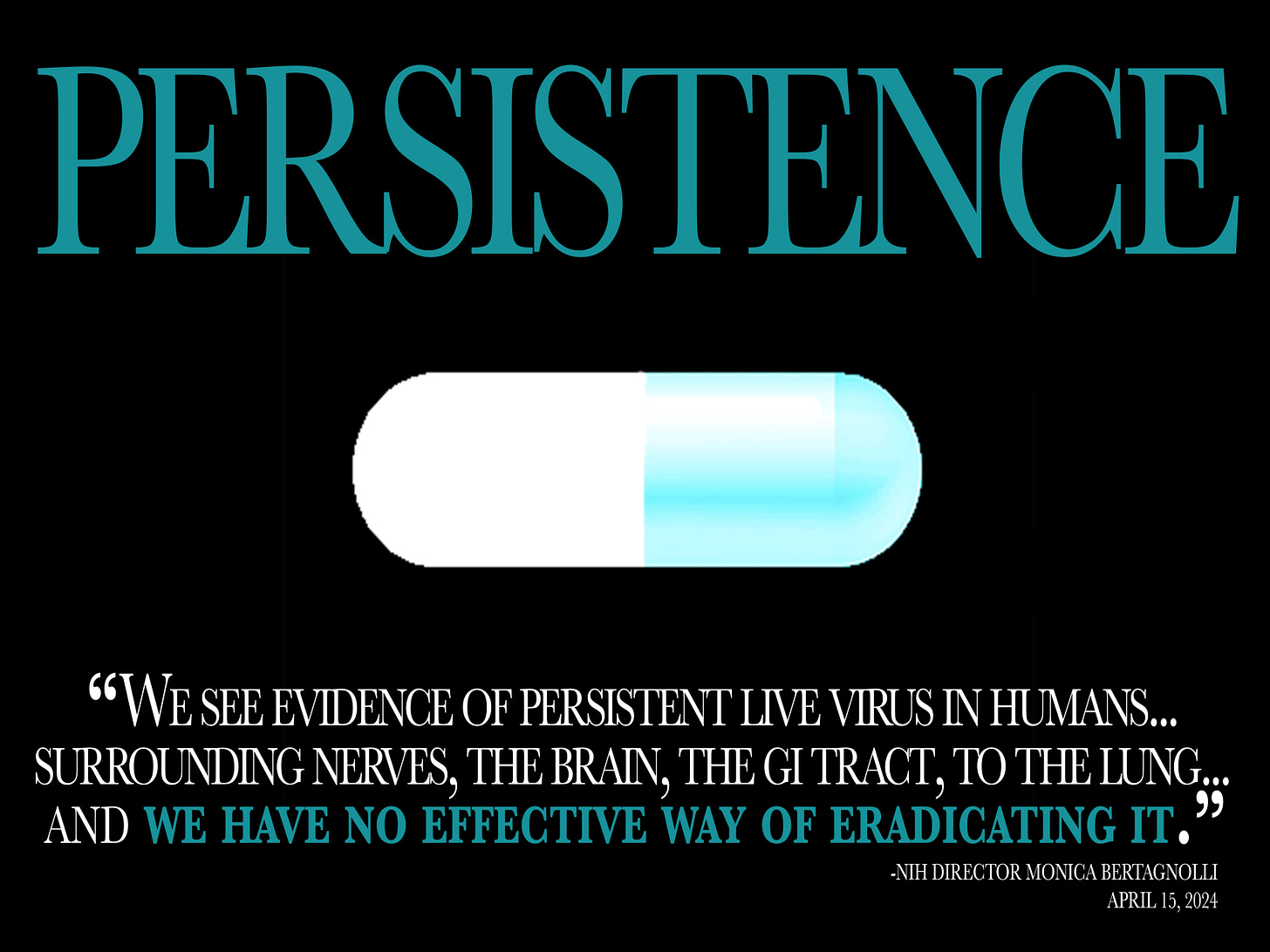
In an interview with Jeremy Faust on April 15, 2024, NIH Director Monica Bertagnolli made several statements that Long COVID patients had been waiting to hear, finally acknowledged by public health officials for four years. I’ll give you a few of the highlights, and you can read the full transcript of the interview here.
(Bertagnolli): “The agent can live for a long time in tissues. It can surround nerve cells…And we have no effective way of eradicating it. Not yet.”
(Bertagnolli): “We see evidence of persistent live virus in humans in various tissue reservoirs, including surrounding nerves, the brain, the GI tract, to the lung.”
(Faust): “And you're saying this goes beyond the PCR's [polymerase chain reaction test] ability to get it in a regular swab so that we are missing chronic cases of SARS‑CoV‑2?”
(Bertagnolli): “Correct. The virus can persist in tissues for months, perhaps even years.”
(Faust): “If that's the case, then it could be reactivated just like herpes is and shingles. Are we going to start seeing people get COVID not from infection, but from themselves in reactivation?”
So what we have is chronic COVID infections - LIVE virus - in human tissue. In our brains, lungs, nerves, GI tracts, and who knows where else. It isn’t detected on PCR tests, and we have nothing to treat it. We’re being offered $1B/yr TO SHARE with a bunch of other “infection-associated chronic conditions” instead of being adequately funded and instead of adequately funding any of those other “IACCs.” No one wins, everyone suffers, the government prospers.
NO.
This is a Long COVID proposal. Focus on Long COVID.
PART III - EXPEDITE LONG COVID RESEARCH

This proposal does not acknowledge or allocate meaningful funding to mitigate the spread of SARS-CoV-2. We all know that the only way to prevent Long COVID is to prevent COVID. It’s been said over and over again. Researching Long COVID "prevention" and "mitigation" without preventing further COVID infections through all of the many ways in which it is possible to slow and stop forward transmission is like prescribing PrEP/PEP without telling patients to use condoms. Dr. Ziyad Al-Aly told the NIH Record back in 2022, “The best way to prevent Long Covid is to prevent Covid in the first place.”
“The best way to prevent Long Covid is to prevent COVID in the first place.”
As for grants and selection…The NIH Director, not the Long COVID research program, will be responsible for the way grant applications are funded. They will be "sought out" and given higher priority if they're supported by "patient orgs with a history of Long COVID advocacy." No specific definitions are provided.
We need CLEARLY DEFINED, transparent legislation and input from more than one federally-backed patient-PAC on the way this is written:
“peer-review process”
“timely manner”
“patient orgs”
“history of Long COVID advocacy”
And again, a decision within 120 days (~4 mos) is faster than the average grant funding timeline of 8-20 months, but it does not convey the urgency with which we need to address this crisis.
In 2018, NIH released a lengthy report and ended a $100M study after allegations of unethical behavior involving NIH scientists and alcohol companies raised questions about funding origins, predetermined outcomes, and missing data.
Conversations between the CDC and Coca-Cola show that the company lobbied to have obesity framed as a “life style changes” rather than sugar found in soda. The FDA panel that approved Vioxx (linked to 85k+ heart attacks) was stacked with doctors with connections to Big Pharma. A few years after Merck voluntarily pulled the drug from the market, a study published in the Journal of American Medicine suggests that the safety oversight on the original study was nonexistent, and Merck utilized the “peer-research” research to create marketing brochures via ghostwriting.
This is nothing new for the American government. It is in line with previously funded NIH Long COVID research initiatives, which, to date, have drawn intense criticism, and produced little useful data. Long COVID patients should seriously consider whether this is the right move for their future, or if they are going to demand better for themselves.
PART IV - ESTABLISH RESEARCH ADVISORY BOARD
Some history on NASEM:
In 2023, a National Academies of Sciences, Engineering, and Medicine committee conducted a series of facilitated, virtual focus groups held with select stakeholders to examine the current U.S. Government (USG) “working definition for Long COVID and related technical terms.” Stakeholders included: patient orgs, practitioners, health agencies, health policy orgs, payers, and health industry businesses. The committee then made recommendations for redefining Long COVID.
In July 2023, American Chemistry Council filed a legal action against NASEM and the EPA, after 18 months of violations. ACC “seeks to have NASEM follow basic principles of independence, transparency, and sound science in accordance with its legal obligations.” NASEM demonstrated a “fundamental failure of this review process to follow the law and basic standards for scientific integrity, independent peer review, and governmental transparency.”
In Oct. 2020, NAM rescinded the membership of a doctor after they “engaged in conduct that included fabrication, falsification, and plagiarism.” NAM then attempted to hide the incident: “Please consider this information highly confidential, only for members.”
In Dec. 2017, NASEM released a comprehensive report on Sexual Harassment of Women in Academic Sciences, Engineering, and Medicine. The 300+ page report spans decades. This sums it up well:
“...the report provides a steady stream of data-driven and evidence-based conclusions that all point to the fact that academic institutions as they exist today are either unwilling to or fundamentally incapable of addressing sexual harassment. The report validates the experiences of many; for many more, it reinforces our frustration with lack of meaningful progress over the last three decades…
Despite many recommendations for how to implement meaningful change included in the report, the way forward remains unclear: when and how can recommendations be implemented? Who will be responsible for overseeing these changes? Can we rely on the National Academies or any other leading scientific and academic institution to meaningfully lead the way on fixing sexual harassment? The Academies are rife with their own issues of sexual harassment and harbour many culprits, yet have been unwilling to enact meaningful change — making it hard to believe that the organization is willing to set an example and lead the charge to hold others accountable.”
NASEM also has a loooong history of being funded by old, right-wing, power hungry conservative money. The Koch family has held influence in the US across NASEM and the arts for as long as any other wealthy WASP family in this country. They’ve named buildings across the states (Lincoln Center, MIT, and others) and hold affluence in NASEM and other organizations. Their descendants sit on committees and in teaching positions, and their word holds weight. They’ve supported the ban on foreign scientists. Paul Koch even released a document on sexual harassment at UC Santa Cruz following the NASEM sexual harassment document, designating himself the point of contact for filing complaints about such incidents so that NASEM could keep them quiet. The Koch family has funded non-profits that spread misinformation about public health. They funded the legal campaign to end the national eviction moratorium while simultaneously purchasing the very real estate companies that stood to benefit from mass evictions (yes, Long COVID patients, you can blame your homelessness on the Koch family). They funded the Great Barrington Declaration. They are NOT ON OUR SIDE.
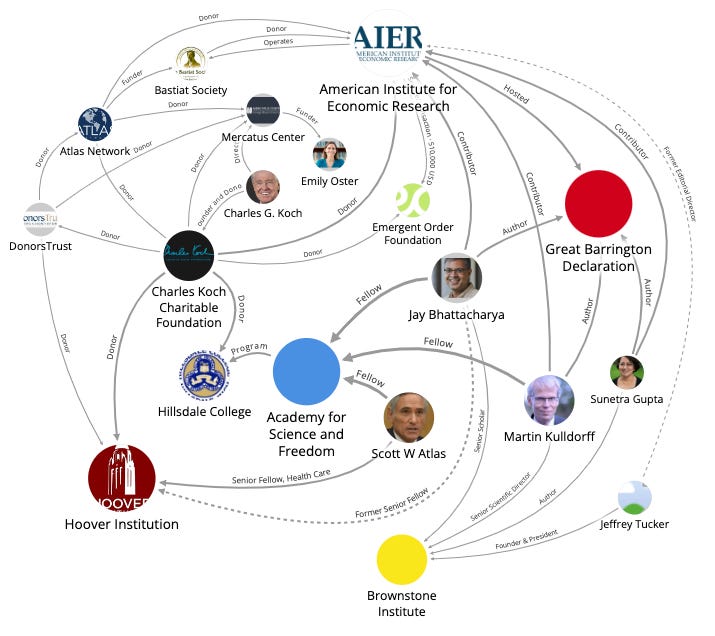
Is reviewing public and private research for the benefit of NIH, or so the government can control the majority of the Long COVID information in the US? How does this effect future NIH work? Need more info here.
If contracted to an org like NASEM, it's fair to say that nominations will be limited to members of NASEM. The public doesn't get to make the nominations - the NIH-contracted, closed-door private org does. While the "public" will have input, that doesn't mean that the nominees will act in the best interest of the Long COVID community, support clean air, respirators, viral persistence, drug repurposing, etc. (Remember - Brian Walitt is leading the NIH Long COVID intramural study, but we don't want him on the Board!)
Diversity of The Board Members
The Board, according to the proposal, is to be "diverse," based on only the following criteria:
6 non-federal Long COVID experts (scientists, healthcare providers + professionals, researchers)
5 non-federal members of the public/pwLC
2 NIH personnel w/Long COVID expertise nominated by the NIH Director or the Director of the Long COVID Research Program
Unspecified number of ex officio members (NIH Institute Directors engaged with Long COVID research)
Board composition should reflect the "diversity of Long COVID population" and should emphasize those with the highest disease burden. If these are the only guidelines for "diversity" and Board member selection, emphasis may be given to 35-50 year-old females, “diverse” in the symptoms Board members have experienced, or selection may be otherwise biased in ways that is not representative of the current Long COVID population as it is.
Long COVID disproportionately affects those who identify with:
(According to 2022 Household Pulse Survey)
Female, transgender, or non-binary
Widowed, divorced, or separated
Black or Latinx
No college degree
Not hospitalized for acute COVID
Reported 2022 household income ≤$35k
A more accurate representation of the Long COVID community might also include any of these criteria:
(Based on additional suggestions)
Inability to work, remote work, or an in-person work environment with or without needed disability accommodations
Difficulty accessing healthcare or being in community with those that have difficulty accessing healthcare
Wearing high-quality respirators when possible to protect oneself and others (for many, this now means at home, too), and/or struggling to access high-quality respirators
Understanding the importance of clean air and ventilation
Staying educated on the risks of COVID and Long COVID, and acknowledging that we are in an ongoing pandemic
Taking other precautions when possible/needed and helping others do the same if in a position to do so
In addition to diversity across:
Professions
Geographic locations
Family size
Age
Other considerations
And after all that, do we really trust that they’ll even listen to patients? Their history says otherwise. After a groups of 725 patients reached out repeatedly to Brian Walitt and an NIH colleague regarding the intramural ME/CFS study, they were told this:
“Our intent is to reach out and get input from a wide variety of folks with expertise and with experience in this illness.
And we have been doing that right from the beginning at NIH through the trans NIH working group, through CFS advisory committee.
We have had multiple meetings with experts in the field and with advocacy groups.And, I must say it has been a challenge for us, because there are...we may not have reached out to everybody and we apologize for that.”
NIH changed nothing, published the intramural study, and (as I mentioned previously) is planning to do the same to Long COVID patients.
PART V - ESTABLISH DATA SYSTEM AND INFORMATION HUB
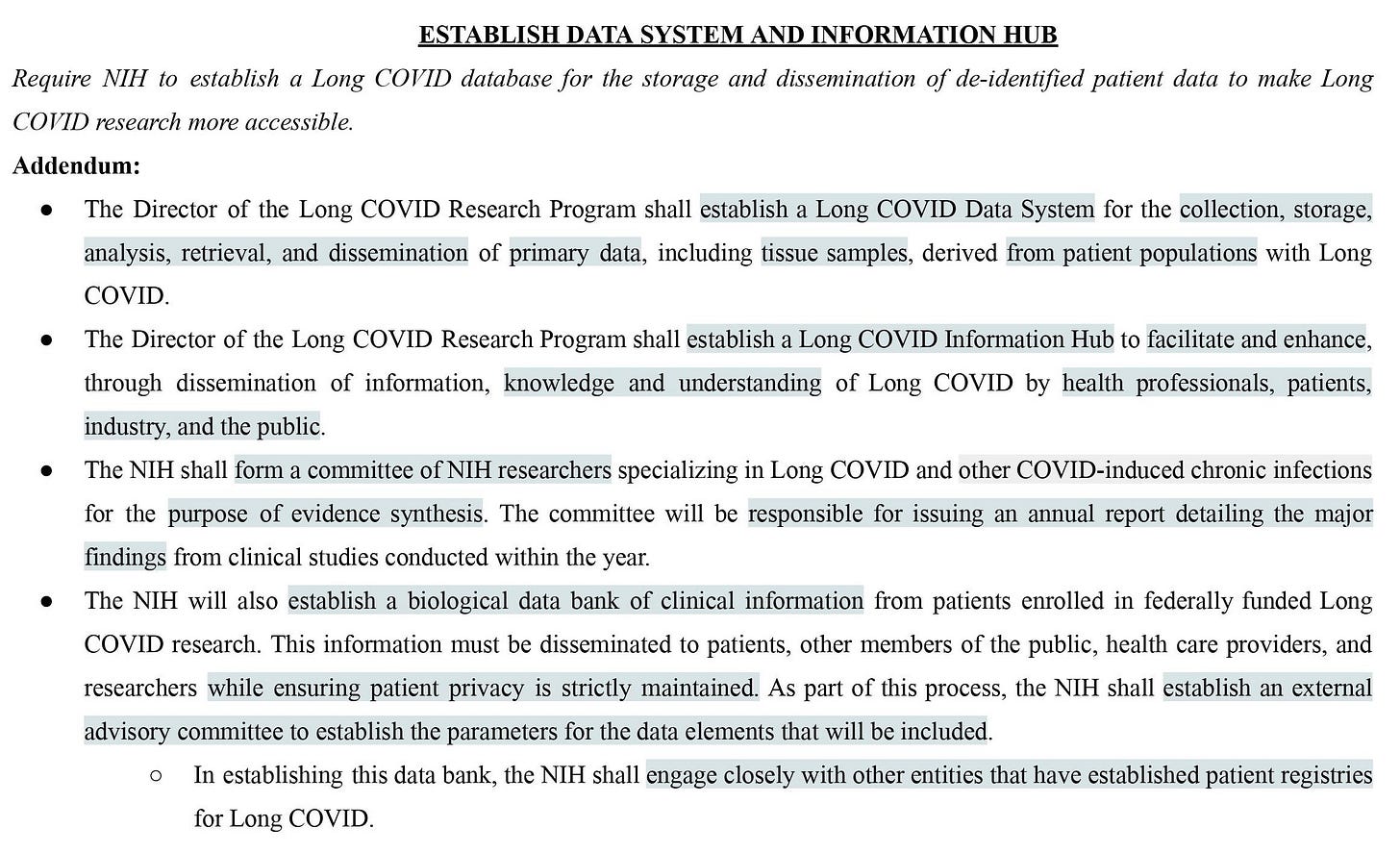
UCSF announced on February 2, 2024 that they would be launching the world’s first tissue bank to study viral persistence in tissue samples donated by Long COVID patients. The UCSF Long COVID Tissue Program is funded through a $3M grant from the Long Covid Research Consortium of the PolyBio Research Foundation. (Congrats to UCSF and PolyBio, by the way!) We should be encouraging the government to further fund this initiative rather than establishing a second tissue database. Traveling, being exposed to in-person care, and the wait times to receive care are all challenges to these initiatives, and we have to use resources more effectively. This means saving time, money, and energy wherever possible.
The federal government already uses patient data however they see fit, with or without our permission. They don’t need to allocate additional research funding to do this. Unlike patients with HIV or, in some states, those with mental health diagnoses, patients with Long COVID have no option to opt-out of this type of de-identified database once they receive medical care. This includes vaccination, reporting COVID test results, accessing acute care treatment, and other care. NIH also uses medical records to train AI on how to “identify” Long COVID. (Be realistic - medical providers don’t even recognize it).
NOW we can talk about “Long COVID and other Infection-Associated Chronic Conditions.”
First, it’s important to know that the CDC chose the term “Infection-Associated Chronic Conditions.” Skip the soft-launch, Maskless Mandy went ALL IN on this one.
In December 2022, the CDC made the new term public by establishing the CDC Foundation’s Infection-Associated Chronic Conditions Understanding and Engagement (ICUE) program. If you’re unfamiliar with the CDC Foundation, they’re funded by state health departments and other private donors like Microsoft, Moderna, Merck, Morgan Stanley, Kaiser, S.C. Johnson, and others. There’s a full list here. After a very public announcement in May 2023 across various social media and other press, ICUE paid out more than $77k to Long Covid Alliance through SolveME to form a new Infection Associated Chronic Conditions Patient Advocacy Coalition. ICUE paid another $73k to a social impact firm called Commonality, Inc. for the same purpose.
I’m all for funding ME, as well as research, treatment, and support for every single chronic illness we’ve been screwing over for decades. It’s unacceptable. Here’s what’s problematic with this particular situation:
SolveME co-founded Long COVID Alliance for the purpose of having more influence over the chronic illness advocacy space. In a very short period of time, Long COVID has been redefined in an effort to secure funding for other “post-viral or infection-associated conditions.”
“Long COVID and associated conditions, myalgic encephalomyelitis/chronic fatigue syndrome (ME/CFS), postural orthostatic tachycardia syndrome (POTS) and other forms of dysautonomia, mast-cell activation syndrome (MCAS), Ehlers-Danlos syndrome (EDS), Lyme disease and other post-viral or infection-associated conditions.”
Commonality lists the CDC Foundation as one of its “select clientele” on its homepage. Is this a grant or a business transaction?
Further, these orgs have continued to partner with the CDC Foundation. Add in Dysautonomia International, Patient-Led Research Collaborative, and COVID-19 Long Hauler Advocacy Project. Funding to these orgs from the CDC and HHS as of summer 2023 totaled $250k.
“The ICUE project team comprised representatives from the CDC Foundation, Commonality, Inc. and the Long COVID Alliance (LCA). Contributing LCA leaders included Solve ME/CFS, Dysautonomia International, COVID-19 Longhauler Advocacy Project and Patient-Led Research Collaborative. Collectively, these organizations developed two virtual engagement sessions on July 11, 2023, and August 7, 2023, with more than 60 participants across 27 IACC patient advocacy organizations…”
It is not problematic to fund organizations, nor it is problematic to engage in advocacy. It is, however, problematic to take hundreds of thousands of dollars from a public health agency that has systematically dismantled infection control, refuses to acknowledge an ongoing pandemic, and will not do even so much as wear respirators to protect the advocates they’re paying off. Infection-Associated Chronic Conditions isn’t an umbrella, it’s a RUG, and we’re all being swept under it.
Remember - we don’t have more now because they settled for less then. Everyone deserves better and it harms us all to accept funding under this term.
Infection-Associated Chronic Conditions isn’t an umbrella, it’s a RUG, and we’re all being swept under it.
Okay. Moving on to data privacy.
In 2008, the CDC awarded the Regenstrief Institute in Indiana a $10M contract over 5 years to improve rapid response and emergency management of infectious disease outbreaks. Upon completion of the 5-year term, in April 2013, Regenstrief announced that they would be licensing their Indiana Network for Patient Care and DOCS4DOCS clinical results delivery software to a for-profit subsidiary of the Indiana Health Information Exchange. The move was described as “unprecedented,” making news as “the single most significant transfer of discovery out of an academic medical informatics research setting to a commercial enterprise in the history of Indiana’s health information technology sector and the national evolution of health information exchange.” The INPC is not limited to Indiana. Their network spans 38 health systems across 347 healthcare facilities and more than 50,000 providers. Participating providers have access to patient records on demand. In 2020, Regenstrief was awarded another contract. This time, a 2-yr, $15M contract to mine data from state electronic health records to determine the measure trends and outcomes of persistent COVID-19 symptoms as part of the National COVID-19 Cohort Collaborative (N3C). Regenstrief continues to work to centralize national metrics in the name of “emergency preparedness” while they advance their own projects.
The 2020 contract came alongside a contract with Datavant - the US’s largest health data ecosystem. Datavant falls under the umbrella of Roivant Sciences, a biotech company founded by former presidential candidate Vivek Ramaswamy. Datavant is valued at approximately $7B, and controls the data of more than 2,000 hospitals and 15,000 clinics.
While Datavant is considered to be pretty top-notch when it comes to data security in the health space, they merged with Ciox Health in June 2021. And Ciox…is not as secure. 15 days after Ciox merged with Datavant, Ciox experienced a data breach lasting 8 days. 32 healthcare providers covering nearly 12,500 people had their data exposed. Ciox didn’t begin notifying providers about the breach until December 2021 - 6 months after the breach.
Regardless, after being granted a CDC contract and joining the NC3 Cohort Collaborative, in October 2023, Datavant was selected to partner with NIH’s Research Program All of Us in establishing the Center for Linkage and Acquisition of Data in Colorado.
In 2017, Google and NIH scrapped a project to publish more than 100k chest x-rays online. The project was intended to showcase the capabilities of Google’s cloud/AI tools and their diagnostic applications. Days before the project went live, Google suddenly realized the x-rays still contained personally identifiable medical information. (AYFKM?) It appears NIH did not look into Google’s history - the company has made similar mistakes both in the US and the UK. The incident finally triggered a government inquiry.
Allowing NIH to be responsible for anything at this point may not be in the best interest of the Long COVID community. NIH has faced hundreds of harassment allegations since they began tracking the data in 2018. In addition to the established lack of transparency, there are concerns around internal favoritism, discrimination, inappropriate behavior, gender discrimination around staff assignments, sexual harassment, and general working environments that lead to less-than-exceptional research. The available data is general, citing “concern about small number and privacy.” NIH talks a good game, but I won’t waste a spoon on hoping for anything they’ve outlined in this proposal. Throughout NIH and the institutions funded by NIH, these issues must be better addressed, or NIH-funded work will be impacted without exception.
And allowing NIH to establish parameters around Long COVID…our trust has already been lost there. In May 2023, a RECOVER-sponsored study published a new working definition of Long COVID, narrowing the focus to “12 distinguishing symptoms.” The list, watered down so as to not terrify the general public, featured:
fatigue
brain fog
loss of sexual desire
feeling thirsty
heart palpitations
twitching
GI problems
Further, the study established a scoring system that assigned a point value to each symptom. Identification of Long COVID would be determined based on a composite score. Long COVID patients were understandably outraged. Hard to be calm when NIH wasted a few million dollars to let researchers dick around and then redefine Long COVID as something they might be able to treat with Adderall, Xanax, Viagra…and a daily dose of completely f—ing ignoring us. Little blue pills all around. We’re cured! (I am, of course, completely kidding. Do not take all that shit together.)
PART VI - PUBLIC EDUCATION AND OUTREACH CAMPAIGN, PROVIDER EDUCATION
So! Who gets to develop this public education campaign?
Centers for Disease Control and Prevention (CDC): Led by Maskless Mandy Cohen, AKA Mass Murder Mandy, the Centers for Disease, Capitalism, and Propaganda has managed to turn Long COVID into a national emergency while removing every tool we have to fight the virus that causes Long COVID and denying that COVID is a problem. The CDC has:
Pushed policies that have led to reduced isolation periods.
Caused states/employers to rescind sick leave policies.
Ended state/federal testing and treatment programs for the most vulnerable populations. The last date to order free COVID tests was March 8, 2024. Test2Treat will end April 16, 2024.
Worked to remove the COVID treatment guidelines in their entirety from the CDC website. The last update was 2/29/24 and the guidelines will be removed 8/16/24.
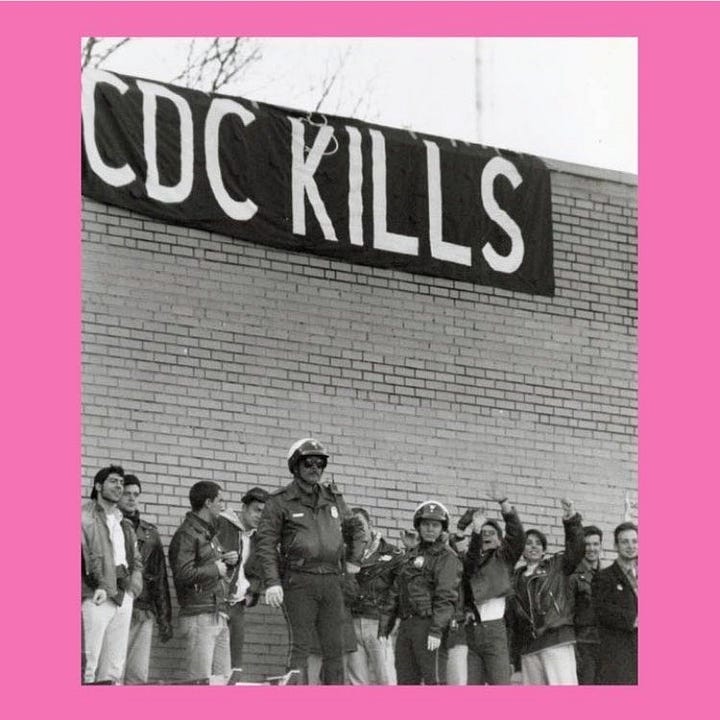
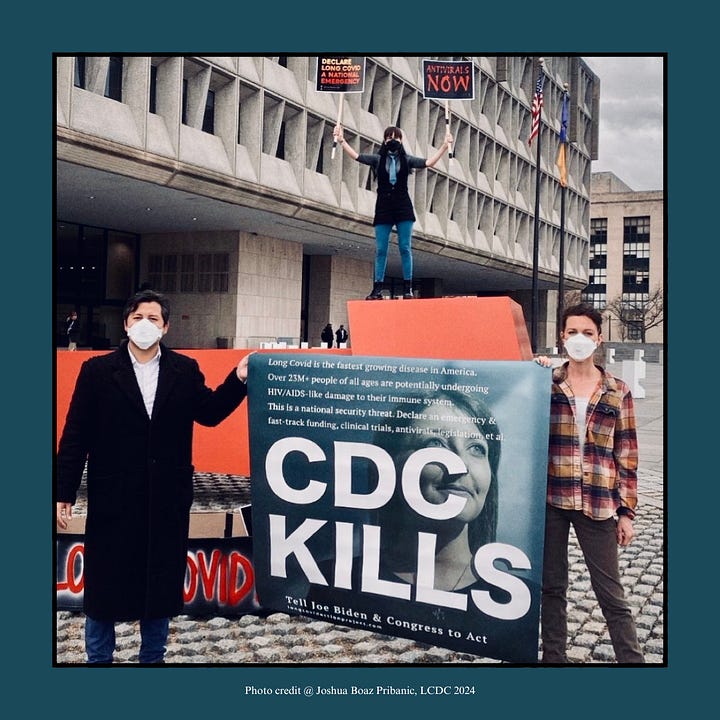
The CDC will go down in history as an agency that would have killed fewer Americans if they’d simply kept their mouths shut.
I wonder if the pain in my bones is viral persistence or my deep, burning hatred for the CDC?
Long COVID Research Program: Underfunded, and brought to you by NIH, the same government agency that brought you RECOVER, which was described by patients as “a waste,” “inaccessible,” with a “complete lack of transparency.”
Research Advisory Board: This will depend very much on the definition of “diversity,” but I don’t think NIH is on the same page as many of the rest of us. We’re thinking “diverse,” and they’re thinking “different infection-associated chronic conditions.” Heads up on that one.
Office of the Asst. Secretary of Health: Admiral Rachel L. Levine, MD. Read her bio if you get a chance. She’s had a hell of a career and she’s fought like hell to get to where she is. Biggest “misstep” appears to be moving her 95-yr-old mother out of a nursing home and into a hotel in May 2020 after being directed by CDC Director Robert Redfield to force nursing homes to accept COVID+ patients back into their care.
State/local health depts: Every state and local health dept. has its own policies, structure, and - depending on political leanings - values that inform state and local public health policy. The expectation that every PHD will cooperate in this political climate is far-fetched and should have been learned by the failures of the early months of this pandemic. As patients, we can’t even access vaccines or the Bridge Access Program currently due to pharmacist biases in different areas, so the NIH (and Congress) were simply writing a wishlist and throwing pennies into a fountain at this point.
Tribal health depts: After the US government stole their land, feds failed to comply with obligations to fund basic services. Now tribal health depts are forced to make do in overcrowded spaces, often without needed supplies, running water, internet, or adequate staff. When a patient advocacy org reached out to Indian Health Services in their home state in 2023 regarding Long COVID advocacy, they received only this response: “Nah.” That’s fair.
Note the careful use of the phrasing “SELF-MANAGEMENT tools.” There is no plan to provide real medical support for us. Providing education about “support services” is not helpful if those support services don’t exist.
Imagine finding out your asthma might be Long COVID. You were handed a flyer as you passed by the community health clinic. You took it to be polite, and you’ve been using it as a bookmark. Today, something caught your eye. “Shortness of breath.” Hmm. Maybe a few days ago, and last week, and…well…all the time now, seems like. After reading the whole flyer, you’re thinking it might be time to see a doctor. The problem is…
You call the clinic and the next available appointment is in 7 months.
Maybe “Long COVID” isn’t really such a big deal after all?
In the Long COVID community, we know to expect the long wait times for care. We know this is a big deal. But how do we reach those that are just getting started, and is the federal government going to do anything to change things? There is no mention of creating those “support services” or bolstering SSA. It will fall on community orgs and individuals. Tell Bernie that we’ve been doing it for years, and a few bucks isn’t going to cut it if he expects us to solve this problem for him. A few bucks isn’t going to create more doctors, hire more nurses, establish more clinics, expand telehealth, or clear the backlog of paperwork that has piled up.
There is no help coming unless we help ourselves.
These materials will be given to Medicare and Medicaid beneficiaries, but the federal government has continued to cut funding for these programs and has failed to acknowledge that these materials need to be distributed online, through the mail, etc. Long COVID patients need these materials distributed contactless, with as little effort as possible. Rural populations need considerations for access, too, by USPS or through senior centers and libraries. Without talking to Long COVID patient populations that are currently doing the real work - not the loudest “advocacy orgs,” but the people really doing the work, this proposal is going to fall woefully short of what is needed. Broad, open-ended, purposefully vague legislation does not help anyone and is a waste of time and money for everyone.
As previously discussed, the CDC has lost all trust from the Long COVID community. Given that the CDC Director is nicknamed “Maskless Mandy” and “Mass Murder Mandy,” and #CDCKills may be one of the only bipartisan hashtags out there, it’s safe to say the Long COVID community is not going to back any proposal that relies on the CDC in any way. The CDC has contributed to the genocide of the American people, and this proposal is a $10B shovel disguised as “education.”
ANY CONDITION CAN OCCUR AFTER A COVID INFECTION. Long COVID is a multi-system, vascular disease that has the capability to infect and persist in every organ and tissue throughout the human body. Avoid infection.
One of the biggest risks to patients is medical providers.
Unmasked. Uninformed. Unsafe.
The number of patients avoiding medical care because they know the risk of being infected by a lack of infection control protocols is causing compounding health problems for many with Long COVID. The federal government has created this situation. It is only going to get worse. Unmasked = unsafe.
Other resources that exist…Unfortunately, resources don’t exist. Unless the federal government intends to list the COVID-Cautious community as a resource, this will be a very short list.
We also need robust telehealth, funded community care, more specialists, support staff, etc. Referrals are not useful when it takes a year to get an appointment, when clinicians will not wear respirators, when a person cannot physically travel to a clinic or an appointment costs thousands of dollars. It also is not helpful when patients wait months for care and are told there is nothing wrong with them. EDUCATE PROVIDERS. LONG COVID IS REAL.
Community groups need to push for more grant funding for multidisciplinary care. The Ryan | Chelsea-Clinton clinic is an excellent model of the way a clinic can be set up to provide primary care services, a specialized care team for a variety of needs, regular follow-up care, mental health care, all at a clinic with on-site Infectious Disease specialists.
And Bernie? End the observational studies. Long COVID is very real. It has fucked us up. We need drugs before our families are applying for death benefits. Do the math. $1,000/person is more than $33/person.
Solutions?
Aside from public comment, get loud! Talk about the corruption happening in NIH and the Long COVID community.
Contact your congressional reps, even if it’s just sending the same email every day.
Tell NIH to open submissions to the Long COVID community rather than creating new educational materials. Let us get paid for our work. Again, it is a waste of time and money to create these materials from scratch. There are plenty of high-quality resources out there. It is insulting to the Long COVID community to exclude us from this work.
Demand inclusion, remote participation, PAID opportunities for creators and other roles. The Long COVID and COVID-Cautious community have been doing this work for free for 4+ years. There is absolutely no reason why all of this can't be done remotely and/or by members of the Long COVID/COVID-Cautious community. ANY and ALL positions should be made available remotely and prioritized to members of our communities FIRST.
Ask the government to hire Long COVID patients to do remote administrative work and help clear backlogs of state and federal applications so patients can start receiving services sooner. Let us work flexible hours. We need the money and the government needs our help.
In accordance with Section 508, virtual meetings and conferences need to meet or exceed established Section 508 guidelines. However, it may be important that NIH consider pwLC have needs not taken into account on this site, and do the work to create an updated accessibility guide before they determine their meetings to be "accessible." Any meetings with in-person, maskless participants and lack of clean air measures will fall short of being accessible for the Long COVID community.
Demand Long COVID patients be given input on what medical interventions are being studied. While it is important to confirm data, time is of the essence, and we are repeating studies that we've been doing for 4 years.
Long COVID patients and allies need more than what this proposal offers.
We need input on guidelines, and future focus, and other aspects of these federal research bodies.
We need respirator mandates, enhanced infection control protocols, and effective clean air mandates.
We need racial, social, disability, and health equity across every aspect of research, treatment, prevention, and support that federal dollars fund.
We need paid sick leave, and for Long COVID patients to qualify as presumptively disabled.
We need patient advocates and accessible home care.
We need free healthcare, and informed providers.
We need up-to-date sharing of information across all research bodies to prevent repetitive studies.
We need at least $28B/yr for Long COVID research directed toward expedient development of viral load tests, drug repurposing including antivirals, and treatment as prevention.
WE NEED LONG COVID DECLARED A NATIONAL EMERGENCY.
This draft proposal looks great at first glance. When you dig a little deeper, it’s just empty words and fake smiles.
This whole thing smells bad, and it isn’t just because the federal government is withholding proper ventilation from the general population.
It's time to TREAT Long COVID. We cannot continue to be left out of the conversation. We need the government to listen to us.
Remember: Something may look good on the outside, but when you get into it, the toxicity will end you faster than doing nothing.
Beware the buttercups.
Stay safe.
-Redd
Email LongCOVIDComments@help.senate.gov with everything you’d like to see to changed and other concerns you have about this proposal (be honest!)
Input will be accepted until Tuesday, April 23, 2024.
You can also call Bernie Sanders’ office at 202-224-5141. (Be sure to request that your call be logged!)



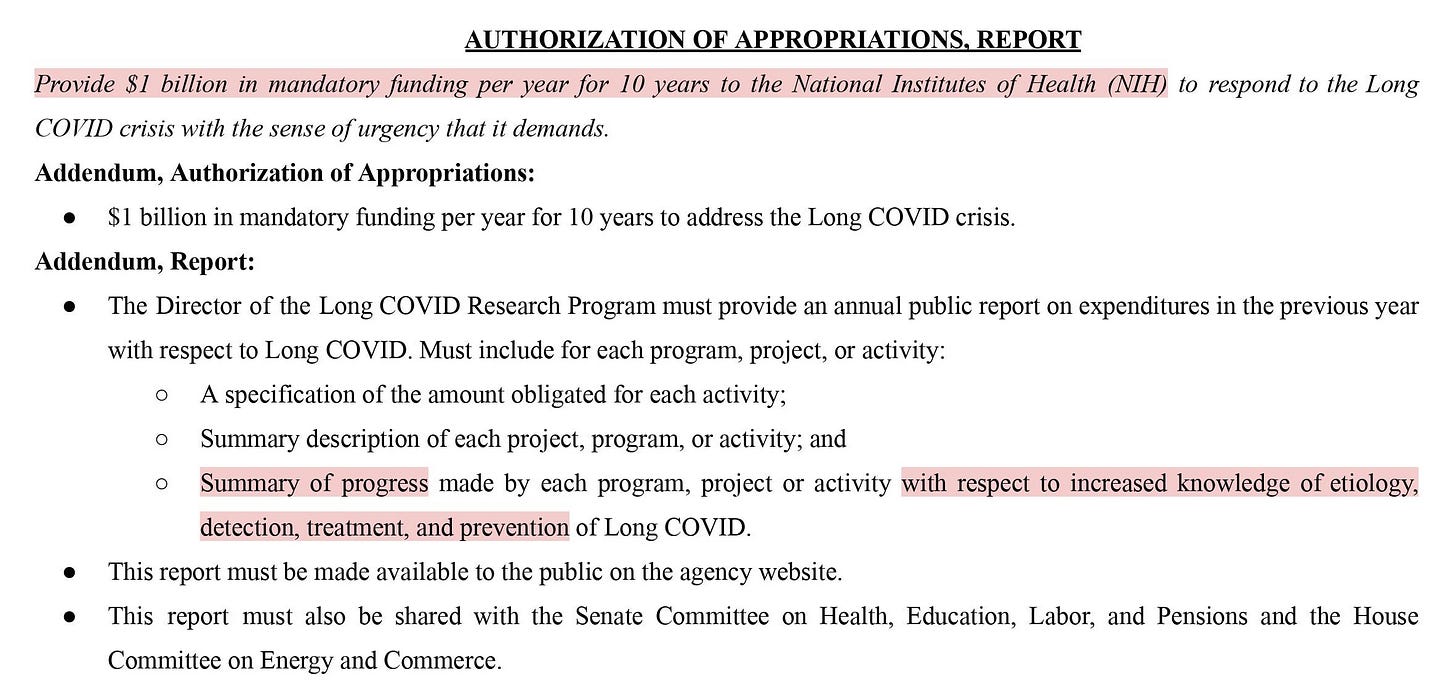
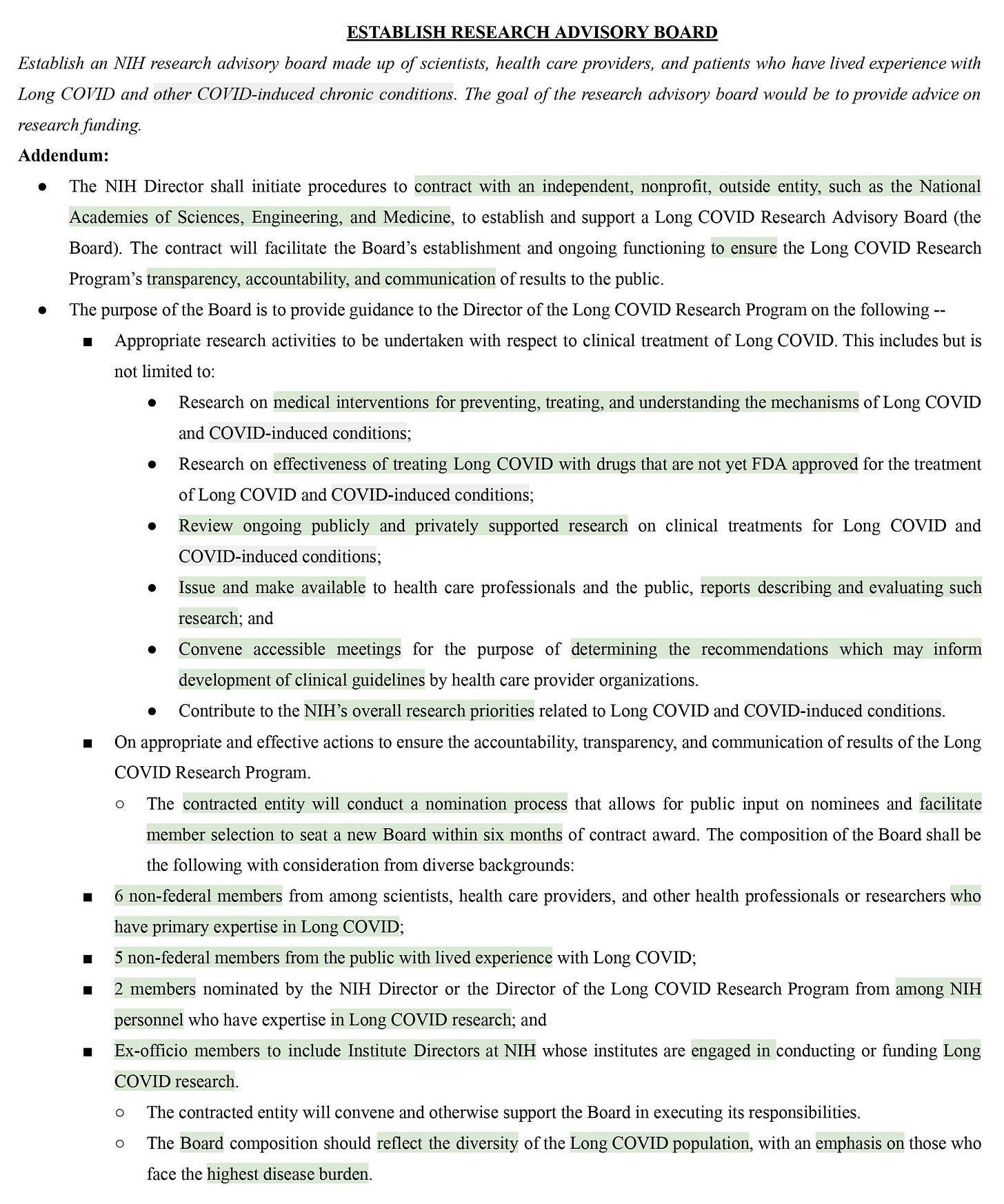
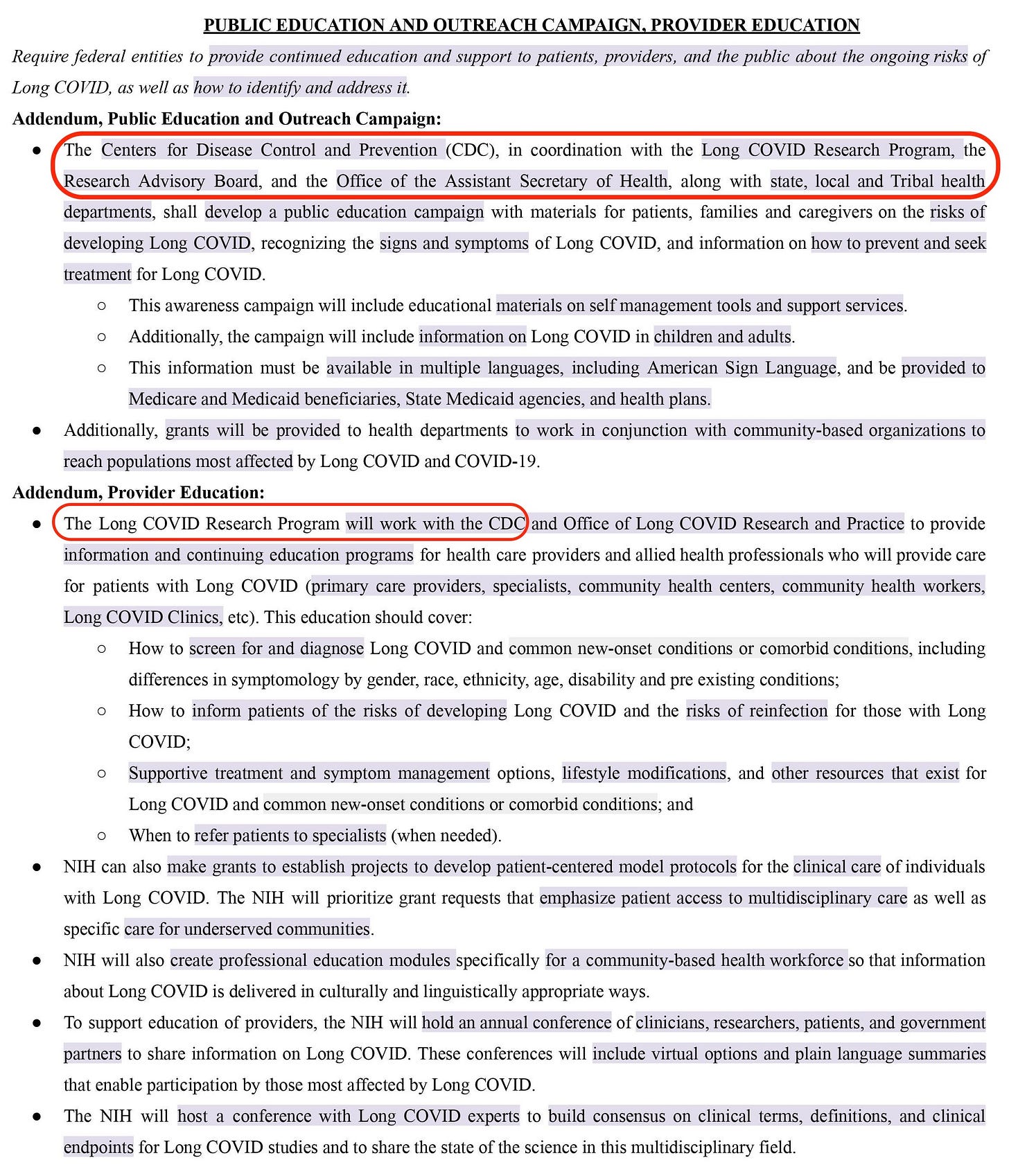
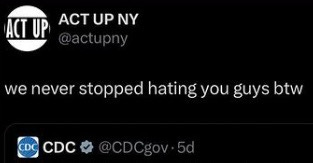
This is an important read for LC advocates. I am an advocate for myalgic encephalomyelitis (34 years sick). You are right to be worried about the "ME/CFS" orgs and HHS, NIH & CDC.
My advocacy focuses on the importance of properly diagnosing patients. This lumping together of patient groups has effectively buried ME for decades. Watching this approach being duplicated to bury the LC patient group that is similar to ME is a huge red flag. The science is showing LC & ME are not identical but it looks like you are facing the same systemic malfeasance.
OMG this is right on the money. You laid it out perfectly. Thank you.